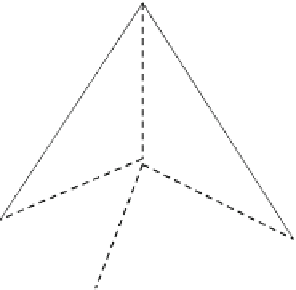Biology Reference
In-Depth Information
Conformons
Bhopalator
Cell Language
IDSs
Cell Force
Figure 10.2a The body-centered tetrahedron representation (BCT) of the Bhopalator model of
the living cell. The four major theoretical elements of the Bhopalator have been proposed between
1972 and 1997 (see Table
10.2A
). The inseparable connections among the four theoretical
components are symbolized by the BCT whose vertices/nodes are in direct contact with one
another without any mediation
Table 10.2A The theoretical components of the Bhopalator (Ji 1985a,b). IDSs
¼
intracellular
dissipative structures. BRE
¼
blackbody radiation-like equation
Theoretical
Components
Reference
Experimental Evidence Discussed in
1
Conformons
Green and Ji 1972a,b;
Ji 2000
Single-molecule
mechanics
of the myosin head
Chapter 8 and Section
11.4.1
Intracellular Ca
++
gradients
2
IDSs
Ji 1985a,b
Chapter 3
3
Cell force
Ji 1991
Whole-cell RNA
metabolic
data fitting BRE
Sections 12.12 and
12.13 & Appendix L
4
Cell language
Ji 1997a,b
Quasi-determinism in
genotype-phenotype
coupling
Sections 6.1.2 and 12.10
nodes without any mediation. The Bhopalator model of the living cell has both
a
physical structure
(see Figures 2.11 and
10.2
) and a
theoretical structure
.
The theoretical structure of the Bhopalator is the
inseparable connectedness
among the four theoretical elements
listed in Table
10.2A
that can be geometrically
represented by BCT. What the BCT representation of the Bhopalator implies is that
“
It is impossible to account for the workings of the living cell without simultaneously taking
into account all of the four theoretical elements, i.e., the conformon, IDS, the cell force, and
the cell language, and that no single theory is therefore sufficient to provide a complete
understanding of the living cell
.”
(10.1a)











